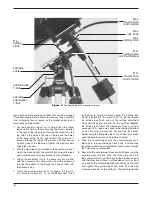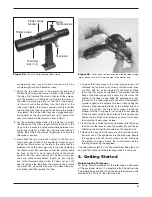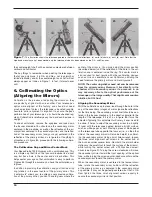
3
table of Contents
1. Unpacking. . . . . . . . . . . . . . . . . . . . . . . . 3
2. Parts List. . . . . . . . . . . . . . . . . . . . . . . . . 3
3. Assembly . . . . . . . . . . . . . . . . . . . . . . . . 3
4. Getting Started . . . . . . . . . . . . . . . . . . . . 6
5. Setting Up and Using the
Equatorial Mount . . . . . . . . . . . . . . . . . . 8
6. Collimating the Optics. . . . . . . . . . . . . . 10
7. Using Your Telescope–
Astronomical Observing . . . . . . . . . . . . 12
8. Care and Maintenance . . . . . . . . . . . . . 15
9. Specifications . . . . . . . . . . . . . . . . . . . . 16
1. unpacking
The entire telescope system will arrive in one box. Be careful
unpacking the box. We recommend keeping the original ship-
ping containers. In the event that the telescope needs to be
shipped to another location, or returned to Orion for warranty
repair, having the proper shipping containers will help ensure
that your telescope will survive the journey intact.
Make sure all the parts in the Parts List are present. Be sure
to check boxes carefully, as some parts are small. If anything
appears to be missing or broken, immediately call Orion
Customer Support (800-676-1343) for assistance.
2. Parts list
Qty.
Description
1
Optical Tube Assembly
1
Optical tube dust cap
2
Optical tube mounting rings
1
25mm (36x) Explorer II eyepiece (1.25”)
1
10mm (90x) Explorer II eyepiece (1.25”)
1
6x30 crosshair finder scope
1
Dovetail finder scope bracket with O-ring
1
Equatorial mount
3
Tripod legs with attached accessory tray bracket
1
Counterweight shaft
1
Counterweight
1
Tripod accessory tray
3
Accessory tray wing screws
(may be attached to accessory tray)
2
Slow-motion control cables
4
Assembly tools (2 wrenches, Phillips head
screwdriver, flat head screwdriver key)
1
Collimation cap
3. Assembly
Assembling the telescope for the first time should take about
30 minutes. No tools are needed other than the ones pro-
vided. All screws should be tightened securely to eliminate
flexing and wobbling, but be careful not to over-tighten or
the threads may strip. Refer to Figure 1 during the assembly
process.
During assembly (and anytime, for that matter), Do not touch
the surfaces of the telescope mirrors or the lenses of the
finder scopes or eyepieces with your fingers. The optical sur-
C
ongratulations on your purchase of a quality Orion telescope. Your new SpaceProbe 130mm EQ is
designed for high-resolution viewing of astronomical objects. With its precision optics and equatorial
mount, you’ll be able to locate and enjoy hundreds of fascinating celestial denizens, including the plan-
ets, Moon, and a variety of deep-sky galaxies, nebulas, and star clusters.
If you have never owned a telescope before, we would like to welcome you to amateur astronomy. Take
some time to familiarize yourself with the night sky. Learn to recognize the patterns of stars in the major
constellations. With a little practice, a little patience, and a reasonably dark sky away from city lights,
you’ll find your telescope to be a never-ending source of wonder, exploration, and relaxation.
These instructions will help you set up, properly use and care for your telescope. Please read them over
thoroughly before getting started.
WArning:
Never look directly at the Sun through
your telescope or its finder scope—even for an
instant—without a professionally made solar filter
that completely covers the front of the instrument, or
permanent eye damage could result. Be sure to also
cover the front of the finder scope with aluminum
foil or another opaque material to prevent physical
damage to the internal components of the scope itself
as well as to your eye. Young children should use this
telescope only with adult supervision.




















